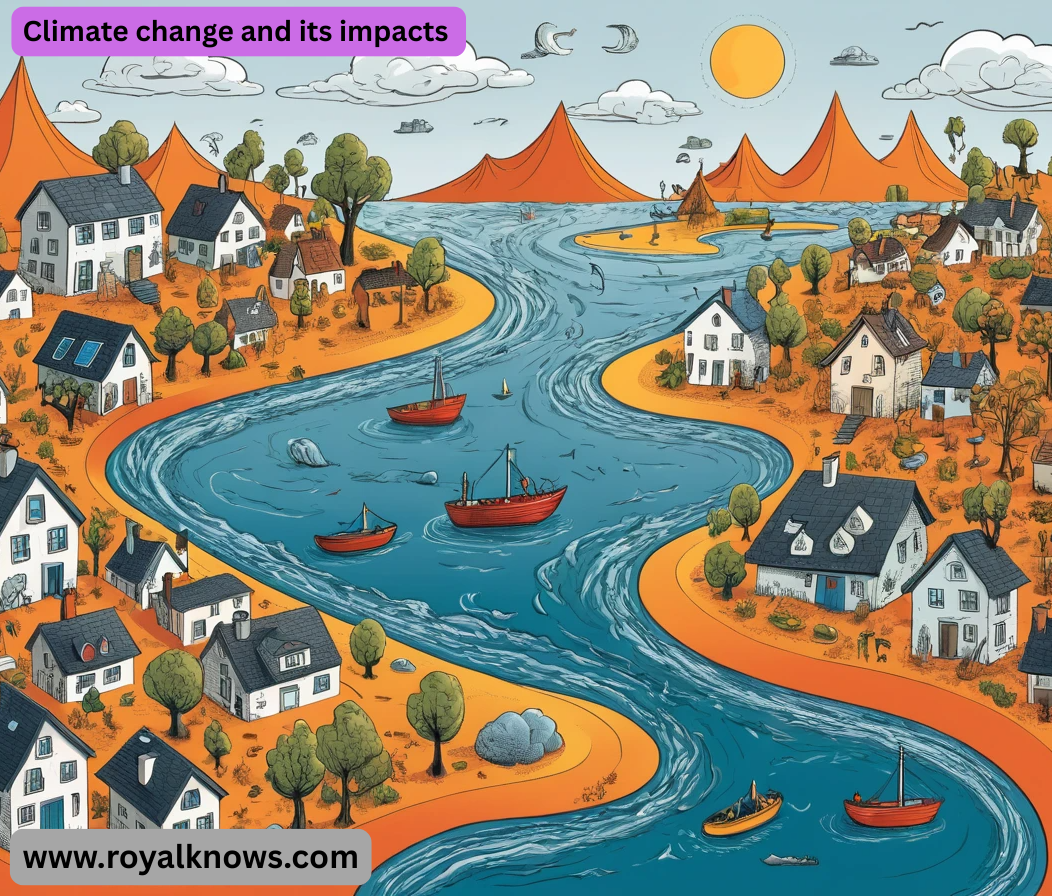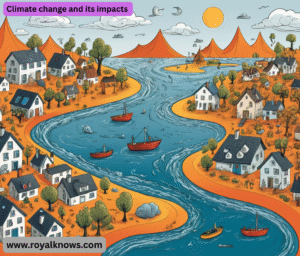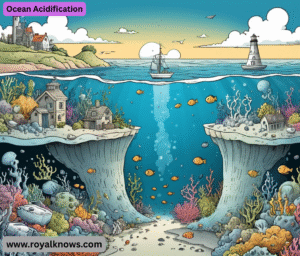Climate change and its impacts Climate change refers to significant, long-term shifts in global or regional climate patterns, primarily attributed to human activities. While Earth’s climate has changed throughout history, the current era of change is remarkable for its pace and primary cause.
- The Greenhouse Effect: The natural process where certain gases in Earth’s atmosphere (like carbon dioxide – CO₂ and methane – CH₄) trap heat from the sun, preventing it from escaping back into space.
- The Enhanced Greenhouse Effect: Human activities, particularly the burning of fossil fuels (coal, oil, gas) for energy, deforestation, and industrial processes, have drastically increased the concentration of these greenhouse gases (GHGS). This thickens the atmospheric blanket, trapping more heat and causing the planet to warm.
The Primary Causes (The Drivers)
- Burning of Fossil Fuels: The largest source of GHG emissions. This includes energy production from coal and gas, powering vehicles with gasoline and diesel, and heating buildings.
- Deforestation: Trees absorb CO₂. Cutting them down not only removes these “carbon sinks” but often releases stored carbon through burning.
- Agriculture: Livestock (like cattle) produce significant methane, and certain fertilizers release nitrous oxide, another potent GHG.
- Industrial Processes: Cement production, chemical manufacturing, and other industries emit large amounts of CO₂ and other gases.
- Waste Management: Landfills are a major source of methane from decomposing organic waste.
The Observed Impacts
- The impacts of climate change are already being felt worldwide and are intensifying. They are interconnected and often create cascading effects.
Rising Global Temperatures
- This is not just about hotter summers; it’s a shift in the entire global climate system’s baseline.
- Extreme Weather Events (More Frequent and Intense)
- Heatwaves: More common, longer-lasting, and more severe.
- Droughts and Wildfires: Higher temperatures dry out soils and vegetation, leading to more severe droughts and creating tinderbox conditions for massive, destructive wildfires (e.g., in Australia, the US West, and Canada).
- Heavy Precipitation and Flooding: A warmer atmosphere holds more moisture, leading to more intense rainfall and catastrophic flooding (e.g., in Pakistan, Germany, and China).
- Stronger Storms: Warmer ocean waters provide more energy for hurricanes and typhoons, making them more intense and capable of carrying more moisture, leading to worse storm surges and rainfall.
Melting Ice and Rising Sea Levels
- Polar Ice Melt: The Greenland and Antarctic ice sheets are losing mass at an accelerating rate.
- Glacial Retreat: Mountain glaciers are disappearing worldwide, threatening water supplies for millions of people.
- Sea Level Rise: Caused by thermal expansion (water expanding as it warms) and meltwater from ice sheets and glaciers. This leads to:
- Coastal erosion and loss of land.
- Saltwater intrusion into freshwater aquifers and agricultural land.
Ocean Acidification
- This acidity makes it difficult for marine organisms like corals, oysters, and plankton to build their shells and skeletons, threatening the entire marine food web.
Impacts on Ecosystems and Biodiversity
- Coral Bleaching: Warmer ocean temperatures cause corals to expel the algae living in their tissues, turning them white and making them vulnerable to disease and death. Mass bleaching events are devastating reefs globally.
- Species Migration and Extinction: Species are moving towards the poles or to higher elevations to find suitable habitats. Those that cannot adapt or move fast enough face extinction.
- Shifts in Seasons: Plant flowering, bird migration, and insect emergence are occurring earlier in the year, disrupting the synchronized timing of ecosystems.
Human and Societal Impacts
- Food and Water Security: Droughts, floods, and unpredictable growing seasons disrupt agriculture, threatening crop yields and food supplies. Glacial melt threatens the water sources for vast populations.
- Health Risks: Increased heat-related illnesses and deaths, wider spread of infectious diseases (like malaria and dengue) as mosquitoes expand their range, and poorer air quality leading to respiratory problems.
- Displacement and Climate Migration: Rising seas and extreme weather are forcing people from their homes, creating climate refugees and increasing the risk of conflict over scarce resources.
- Economic Costs: The financial toll of climate change is enormous, from rebuilding after disasters, lost productivity, and rising healthcare costs.
What Can Be Done? (Mitigation and Adaptation)
Addressing climate change requires a two-pronged approach:
- Mitigation: Reducing Emissions to Limit Future Change
- Transition to Renewable Energy: Rapidly phasing out fossil fuels for solar, wind, geothermal, and hydropower.
- Energy Efficiency: Using less energy in buildings, transportation, and industry.
- Protecting Forests: Ending deforestation and promoting reforestation and afforestation.
- Sustainable Agriculture: Changing farming practices to reduce emissions and store more carbon in soil.
- Innovation: Developing new technologies for carbon capture and storage (CCS) and green hydrogen.
Adaptation: Adjusting to Current and Expected Impacts
- Building Resilient Infrastructure: Designing seawalls, improving stormwater systems, and reinforcing bridges and roads.
- Developing Early Warning Systems: For storms, heatwaves, and floods.
- Climate-Smart Agriculture: Developing drought-resistant crops and more efficient irrigation systems.
- Protecting and Restoring Ecosystems: Mangroves and wetlands act as natural buffers against storms and coastal erosion.
Beyond the Basics: Nuances and Deep Dives
Tipping Points and Irreversible Change
- A major concern among scientists is the concept of climate tipping points—critical thresholds in the Earth system. If crossed, they can lead to sudden, irreversible, and self-perpetuating change, even if global warming stops.
Examples of Potential Tipping Points:
- Collapse of the Greenland and West Antarctic Ice Sheets: Once a certain level of melting occurs, their collapse could become unstoppable, committing the world to massive sea-level rise over centuries.
- Dieback of the Amazon Rainforest: Drought, deforestation, and fire could push the Amazon to a point where it can no longer support itself as a rainforest, transforming into a savanna and releasing vast amounts of stored carbon.
- Shutdown of Atlantic Ocean Circulation (AMOC): The system of currents that regulates climate in Europe and beyond is slowing. A full collapse would drastically alter weather patterns globally.
- Thawing of Permafrost: Arctic permafrost holds vast amounts of methane, a potent GHG.
The Inequality of Impact
- Climate change is profoundly unjust. Its burdens fall hardest on those who are least responsible for causing it.
- Global North vs. Global South: Historically, developed nations have emitted the vast majority of GHGs. Yet, many developing nations, often located in hotter climates and with fewer resources to adapt, face the most severe consequences (e.g., drought in the Sahel, sea-level rise threatening small island nations).
- Within Societies: The poor, elderly, children, indigenous communities, and marginalized groups are more vulnerable. They may live in higher-risk areas (floodplains, urban heat islands), have less access to air conditioning or healthcare, and possess fewer resources to recover from disasters.
Economic and Systemic Risks
- Climate change is not just an environmental issue; it’s a fundamental threat to global economic stability.
- Stranded Assets: As the world transitions to a low-carbon economy, vast reserves of coal, oil, and gas may become unusable, wiping out trillions of dollars in value for companies and investors and potentially destabilizing markets.
- Supply Chain Disruption: Extreme weather can halt production and disrupt complex global supply chains for everything from food to electronics, causing price spikes and shortages.
- Financial Instability: The increasing frequency of billion-dollar disasters strains insurance companies, banks, and public disaster relief funds.
The Role of Individual vs. Systemic Change
- While individual actions (like recycling, flying less, or eating a plant-based diet) are important for raising awareness and building momentum, they are insufficient on their own.
- The core solution requires systemic change driven by policy and innovation. This includes:
- Government Policy: Carbon taxes, massive investment in green infrastructure, updating building codes, and ending subsidies for fossil fuels.
- Corporate Responsibility: Major corporations and investors must decarbonize their operations and supply chains.
- Technological Innovation: Scaling up renewables, developing energy storage, advancing carbon capture, and creating green materials (e.g., low-carbon cement).




